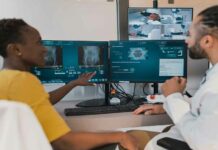XENEX, a world leader in UV technology-based infection reduction strategies and solutions, chose AT&T to connect their LightStrike™ Germ-Zapping Robots™ which use intense pulsed xenon ultraviolet (UV) light to deactivate viruses, bacteria and spores on surfaces.
Equipping the XENEX robots with AT&T Internet of Things connectivity provides the data XENEX and hospitals need to optimize robot performance, reduce healthcare costs and optimize efforts to avoid infections as they work to provide additional levels of safety during the COVID-19 pandemic.
“Our ability to receive the data quickly and know that it is accurate is of utmost importance. It helps us analyze how our customers’ disinfection programs are performing, which can have a dramatic impact on their ability to reduce their infection rates. That data is provided to us through AT&T.”
Wirelessly connecting the robots helps ensure that they operate at peak performance. The connectivity also helps to automate the robots’ communication and data transfer processes and gives XENEX and hospitals access to rich performance information:
Documents each room the robots disinfect, for how long the robot was operated, and by which operator.
Helps hospitals meet standard operating protocol (SOP) goals.
Provides proactive diagnostics to ensure that the robots perform properly.
Offers near real-time maintenance information – notifies when an issue is encountered to ensure valuable equipment is in good working order.
Enables the devices to accommodate future technologies.
Allows control of software upgrades without interrupting customer operations.
Healthcare associated infections (HAIs), which some patients contract while receiving treatment for medical or surgical conditions, are the bane of hospitals and other healthcare facilities. Keeping hospitals as germ-free as possible is a critical patient safety issue and an ongoing challenge. This reality has only been exacerbated during the COVID-19 crisis.
“IoT connectivity can play a critical role in healthcare and that’s never been more apparent than during the COVID-19 pandemic,” said Chris Penrose, senior vice president of Advanced Solutions at AT&T. “AT&T is providing global connectivity for XENEX’s virus-killing robots. Through a single cloud-based platform, we can deliver visibility and agility – allowing XENEX the ability to dynamically adapt to a changing business.”
The XENEX robots perform environmental disinfection that’s been shown to be more effective than traditional cleaning methods. After physically cleaning rooms by changing the linens and removing trash and visible dirt, hospital staff turn on the robot and then leave the room. The droid-like robot creates intense flashes of pulsed xenon UV light that quickly destroy pathogens on surfaces that may have been missed during the manual cleaning process. A LightStrike robot can disinfect an entire patient room in as little as 10 minutes.
The robots have been proven effective against the most dangerous microorganisms like Ebola and anthrax as well as more common pathogens like MRSA (methicillin-resistant Staphylococcus aureus), Clostridium difficile (C.diff) and influenza. The LightStrike robot has also been proven effective at deactivating Middle Eastern Respiratory Syndrome (MERS) coronavirus.
The AT&T relationship supports XENEX’s mission to save lives and reduce suffering by destroying the deadly microorganisms that cause HAIs. During this pandemic it is even more critical to help hospitals achieve infection reduction goals, safeguard patients and employees, and reduce cost.
















